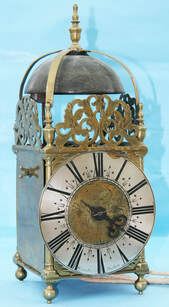|
Daniel Quare was one of the most important clockmakers in England at the end of the 17th century and probably only second to Thomas Tompion. Quare excelled not only as a clock and watchmaker but also as a barometer maker. His customers included European Royalty and Heads of State of many countries. Daniel Quare is thought to have been born about 1647/8 in Somerset to Quaker parents. He would have been apprenticed about 1662-1669 and appeared in the London parish of St Martin le Grand by 1671 and joined the Clockmakers’ Company as a brother on 3 April 1671 when he was described as a “great clockmaker”. Great clockmaker, was a term the C.C. used to disguise the fact that they were enrolling freemen of other London companies. Several clockmakers free of the Blacksmiths’ Company were described in the same way when they joined the C.C.
It is interesting to compare the contrasting lives of these two Quaker clockmakers. Daniel Quare was so successful he made a fortune selling his clocks, while Ninian Burleigh struggled to earn enough money to feed his family. Very few of his clocks appear to have survived, while Daniel Quare’s clocks are found in many museums and also in Royal collections, as well as being treasured by many private collectors. Other clockmakers who were from the North or worked in the North of EnglandThe clockmaker John Nelson, trained in the B.C. by Gilbert Nelson, was also working in Durham by 1683 when his daughter Lydia was baptised there on 18th June. John’s wife Lydia died in July 1685 and he was remarried a widow, Philadelphia Bellamy at Heddon on the Wall on 29th August 1686. They then had three children all baptised in Durham, William on 15 Sept 1687, John on 11 Feb 1689/90 and Ralph on 21 Feb 1692/3. John Nelson must have worked in Newcastle in the 1690s because when his will was proved in April 1700 he was described as a clockmaker formerly of Newcastle. Two of Nelson’s sons became clockmakers. In 1711 John junior was described as a “busher of Durham” when he signed a document but he later worked as a clockmaker as did Ralph Nelson by 1715. John Junior must have been marking out the movement plates of clocks and drilling the holes for the wheel pivots, hence the modern term of “rebushing the plates” when the brass around the holes is worn away. Martin Jackson baptised at Brancepeth, Durham in July 1671 was apprenticed in Durham, presumably to John Nelson senior (1685-1692). Martin appeared to leave Durham for London with a former school friend from Bracepeth, William Threlkeld in 1697, where he joined the Clockmakers Company on 1 Nov 1697. Martin must have also taken with him his apprentice Jasper Harrison who had been baptised in Chester-le-Street, Durham on 3 May 1680 and who returned to Newcastle about 1703 to established his business there, having married in London. Martin Jackson eventually became master of the C.C. in 1721 by which time he was supplying watches to a number of clockmakers including Daniel Quare and Jasper Harrison (see Early clock and watchmakers of the Blacksmiths’ Company). The village of Brancepeth, near Durham was important not only for its castle, but also for the number of goldsmiths and clockmakers who were born there, some of whom worked in Newcastle, while others went to London. If you are interested in Clockmakers from the North of England, please consider buying a copy of my book Clockmakers of Northumberland and Durham. Not all antique clockmakers were in the Clockmakers' Company. Find out more about Early Clock and Watchmakers of the Blacksmiths' Company
0 Comments
Leave a Reply. |
AuthorKeith Bates is an amateur horologist who has been researching clocks, watches and chronometers and their makers for over 30 years. Archives
August 2023
Categories
All
|




 RSS Feed
RSS Feed